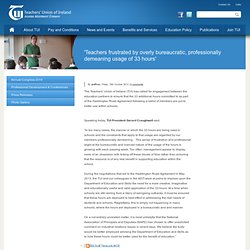

5 Steps to Foster Grit in the Classroom. Photo credit: iStockphoto The word "grit" suggests toughness and determination.

The question is how do we get students to value struggle, failure and perseverance in our classrooms? ASCD recently published Thomas Hoerr's short but great book on this subject, Fostering Grit. The subtitle "How do I prepare my students for the real world? " reflects the fact that our students will encounter challenging work and problems to solve. Model Grit Modeling is a crucial component in teaching skills to students. Don't Grade Formative Assessments. BaBX8CRCUAIX6nK. A Mobile Dilemma. About three years ago, while I was teaching education at a local college, I was attempting to do an observation of one of my students at her student teaching assignment.

It was my first time visiting that high school, so I found myself running late in traffic. I attempted to call my student on her cellphone to let her know that I might be a little late, but she never answered. I texted her, but she never responded. This forced me to try to make it on time. As I entered the high school lobby I found a structure inside that resembled Dr. I believe that was also the year that a New Jersey middle school principal grabbed national attention as he not only banned all cellphones in his school, but also urged all parents to deny their children access to social media, because he felt it was unnecessary. A Critical 21st Century Skill Now here we are in the year 2014, and things seem to be changing for many schools. Digital Literacy for Teachers. Digital literacy 'as important as reading and writing' 'Teachers frustrated by overly bureaucratic, professionally demeaning usage of 33 hours. The Teachers’ Union of Ireland (TUI) has called for engagement between the education partners to ensure that the 33 additional hours committed to as part of the Haddington Road Agreement following a ballot of members are put to better use within schools.

Speaking today, TUI President Gerard Craughwell said: “In too many cases, the manner in which the 33 hours are being used in schools and the constraints that apply to that usage are regarded by our members professionally demeaning. This sense of frustration and professional slight at the bureaucratic and coerced nature of the usage of the hours is growing with each passing week. Too often, management appear to display more of an obsession with ticking off these blocks of time rather than ensuring that the resource is of any real benefit in supporting education within the school. When Class Size Matters: A Tale Of Two Teaching Styles. When Class Size Matters: A Tale Of Two Teaching Styles by Paul Barnwell, Teacher of English and Digital Media and blogger at mindfulstew Mr. Jones, a passionate teacher relying mostly on direct instruction and lecture, sees his class size fluctuate between 20 and 31 every semester.
No matter the number of students squeezed into desks, his principal notices that most kids seem engaged, and end-of-the-year test scores are amongst tops in the school in Mr. Jones’s classroom when adjusted for student growth. But here’s the rub: this type of thinking further inhibits innovation in schools because of what we’re valuing. Class size matters if you believe in active, Project-Based Learning.
Class size matters if you allow for student choice and authentic personalization. Compared to Mr. Teacher Evaluation: An International Perspective. 2013 International Summit on the Teaching Profession How do we define teaching quality?

How should teachers be evaluated? And how should school systems make use of the evaluations? Vivien Stewart, senior advisor to Asia Society and the author of the Summit reports, shares some of the discourse from the 2013 International Summit on the Teaching Profession, held in the Netherlands, March 2013. by Vivien Stewart The third in a series of unique gatherings of ministers of education and teacher union leaders, the 2013 International Summit on the Teaching Profession brought together delegations from the top 25 countries on OECD's PISA assessment of student achievement as well as from several rapidly improving countries.
Download the full report. Why evaluate teachers? Despite the often-contentious nature of discussions of teacher evaluation, there are, in fact, broad areas of agreement between governments and teachers organizations. Finland's education ambassador spreads the word. Imagine a country where children do nothing but play until they start compulsory schooling at age seven.

Then, without exception, they attend comprehensives until the age of 16. Charging school fees is illegal, and so is sorting pupils into ability groups by streaming or setting. There are no inspectors, no exams until the age of 18, no school league tables, no private tuition industry, no school uniforms. Children address teachers by their first names. Even 15-year-olds do no more than 30 minutes' homework a night. The national curriculum is confined to broad outlines. It sounds like Michael Gove's worst nightmare, a country where some combination of teachers' union leaders and trendy academics, "valuing Marxism, revering jargon and fighting excellence" (to use the education secretary's words), have taken over the asylum. Even the management consultancy McKinsey, which has spearheaded the global movement for testing, "accountability" and marketisation, acknowledges that Finland is top.